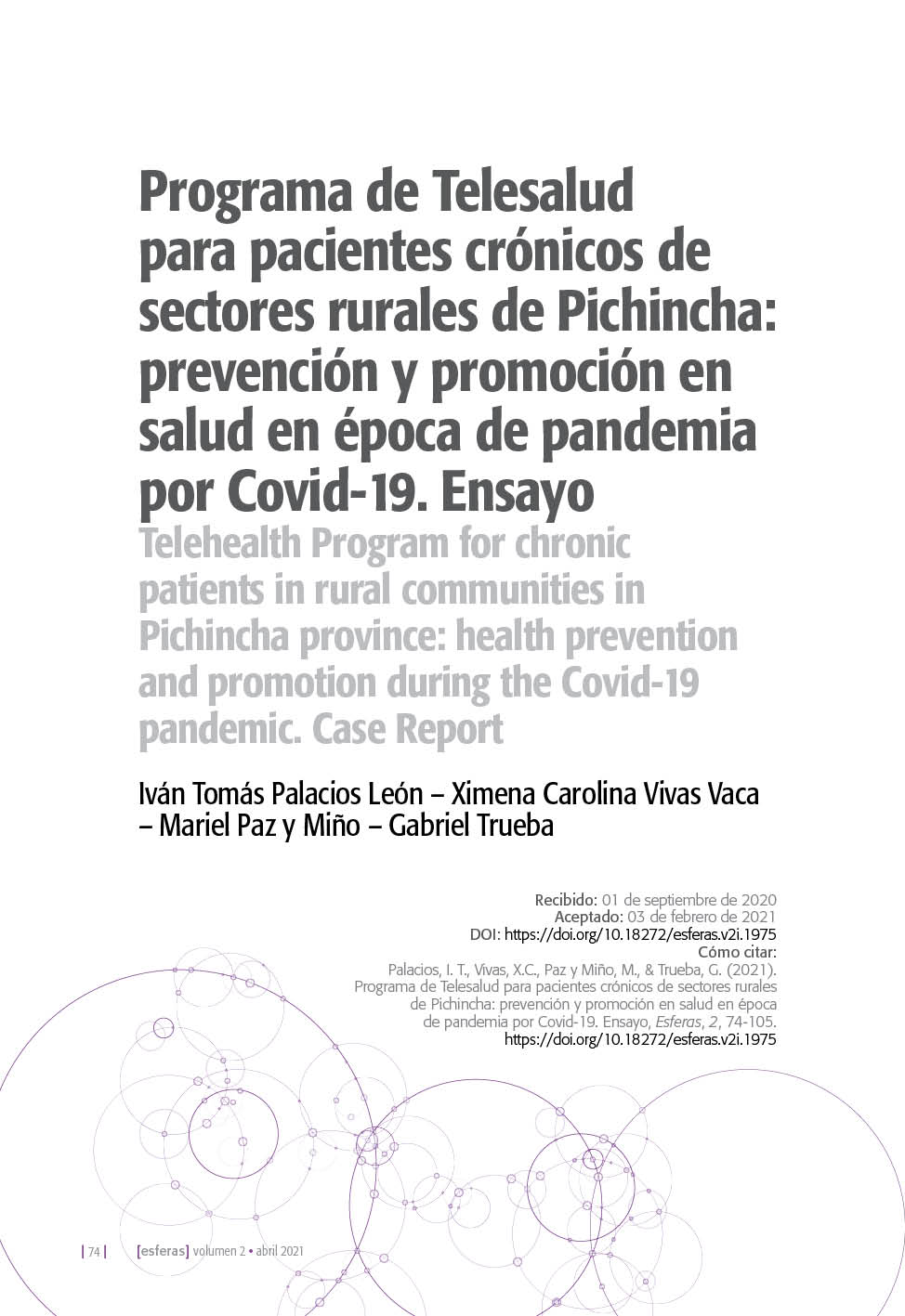
Publicado 2021-04-06
Palabras clave
- prevención de Covid-19,
- seguimiento pacientes crónicos,
- vinculación con la sociedad,
- salud mental durante pandemia,
- enfoque bio-psico-social
- sector rural ...Más
Cómo citar
Resumen
El presente estudio de caso se refiere a la experiencia en fase de implementación por parte de profesores, alumni y estudiantes de diferentes escuelas de la Universidad San Francisco de Quito, el Ministerio de Salud Pública (MSP), y pacientes vulnerables durante la pandemia del Covid-19 (del 23 de marzo de 2020 al 12 de diciembre de 2020). La Organización Mundial de la Salud (OMS) advirtió desde el inicio de la pandemia que los grupos con mayor vulnerabilidad de desarrollar Covid-19 de manera grave o tener alta mortalidad son la población adulta mayor y personas que sufren enfermedades crónicas como diabetes e hipertensión. Frente al riesgo de contagio de esta población vulnerable del sector rural de Pichincha, la Escuela de Medicina de la Universidad San Francisco de Quito (USFQ) diseñó el "Programa de Telesalud para pacientes crónicos de sectores rurales de Pichincha". Participaron como voluntarios del programa graduados (alumni), estudiantes y docentes de las escuelas de Medicina, Psicología, Nutrición y Microbiología; además, médicos de los centros de salud del primer nivel del Ministerio de Salud Pública. Los objetivos del programa fueron atender mediante llamadas telefónicas para fortalecer estilos de vida saludables, principalmente en cuanto a dieta y actividad física, por medio de charlas, mejorar la adherencia al tratamiento de patologías preexistentes, y brindar apoyo nutricional y psicológico. Además, se llevaron a cabo otras actividades complementarias para prevenir el contagio de Covid-19, como entregar visores faciales a pacientes y personal de salud, y aplicar pruebas gratuitas de SARS-CoV-2 RT-PCR, las cuales se administraron en los centros de salud y hospitales intervinientes, y se procesaron en el laboratorio de Microbiología de la USFQ. Esto se efectuó mediante un protocolo diseñado para el efecto, que sigue los lineamientos de la OMS y del MSP del Ecuador. Se evaluó el programa mediante el análisis FODA (fortalezas, oportunidades, debilidades y amenazas). Durante el periodo reportado, se tuvo un impacto directo en 8,598 personas, las cuales se han beneficiado del Programa de Telesalud, incluyendo pacientes que recibieron atenciones vía telefónica de medicina, asesoría nutricional y asesoría psicológicas, y 3,115 personas que se aplicaron pruebas SARS-CoV-2 RT-PCR.
Descargas
Citas
- McIntosh, K. (2020). Coronavirus disease 2019 (Covid-19): Epidemiology, virology, and prevention. En M. Hirsch (Ed.), UpToDate. Recuperado de: https://www.uptodate.com/contents/coronavirus-disease-2019-Covid-19-epidemiology-virology-and-prevention?search=Coronavirus%20disease%202019%20(Covid-19):%20Epidemiology,%20virology,%20and%20prevention&source=search_result&selectedTitle=1~150&usage_type=default&display_rank=1#references
- Palacios, M., Santos, E., Velázquez Cervantes, M.A. & León Juárez, M. (2020). Covid-19, a worldwide public health emergency. Revista Clínica Española (English Edition). doi: https://doi.org/10.1016/j.rce.2020.03.001
- Organización Mundial de la Salud. (2020, abril 27). Covid-19: cronología de la actuación de la OMS. Recuperado de: http://web.archive.org/web/20200830151345/https://www.who.int/es/news-room/detail/27-04-2020-who-timeline---Covid-19
- Deng, S. & Peng, H. (2020). Characteristics of and Public Health Responses to the Coronavirus Disease 2019 Outbreak in China. J. Clin. Med. 9(2), 575. doi: https://www.mdpi.com/2077-0383/9/2/575/htm
- Ministerio de Salud Pública del Ecuador. (2020). Documentos normativos Covid-19 Ecuador: Acuerdo N.o 00126-2020 Emergencia Sanitaria Sistema Nacional de Salud. Recuperado de: http://web.archive.org/web/20200626083240/https://www.salud.gob.ec/wp-content/uploads/2020/03/SRO160_2020_03_12.pdf
- Organización Mundial de la Salud (2020, junio 29). Prevención y control de infecciones durante la atención sanitaria a casos presuntos o confirmados de Covid-19. Recuperado de: http://web.archive.org/web/20200830164929/https://apps.who.int/iris/bitstream/handle/10665/333389/WHO-2019-nCoV-IPC-2020.4-spa.pdf
- Organización Mundial de la Salud. (2020). Telesalud. Recuperado de: http://web.archive.org/web/20180716061133/https://www.paho.org/ict4health/index.php?option=com_content&view=article&id=9684:telehealth&Itemid=193&lang=es
- Chauhan, V., Galwankar, S., Arquilla, B., Garg, M., Somma, SD., El-Menyar, A., Krishnan, V., Gerber, J., Holland, R. & Stawicki, SP. (2020). Novel Coronavirus (Covid-19): Leveraging Telemedicine to Optimize Care While Minimizing Exposures and Viral Transmission. J Emerg Trauma Shock 13(1), 20-24. doi: 10.4103/JETS.JETS_32_20. Epub 2020 Mar 19. PMID: 32308272; PMCID: PMC7161346.
- Organización Mundial de la Salud (2020, marzo 23). Information note Covid-19 and NCDs. Recuperado de: http://web.archive.org/web/20200830164243/https://www.who.int/publications/m/item/Covid-19-and-ncds
- Basu, S. (2020). Non-communicable disease management in vulnerable patients during Covid-19. Indian journal of medical ethics, (2), 103-105. doi: https://doi.org/10.20529/IJME.2020.041
- Ministerio de Salud Pública (2012). Manual del modelo de atención integral del Sistema Nacional de Salud Familiar Comunitario e Intercultural (Mais-Fci). Quito: Subsecretaría Nacional de Gobernanza de la Salud Pública. Dirección Nacional de Articulación del SNS y Red. Recuperado de: http://web.archive.org/web/20200709022952/http://instituciones.msp.gob.ec/somossalud/images/documentos/guia/Manual_MAIS-MSP12.12.12.pdf
- Ministerio de Salud Pública del Ecuador. (2019). Hipertensión arterial: Guía de práctica clínica (GPC). Quito: Dirección de Normatización. Recuperado de: http://web.archive.org/web/20200830153836/https://www.salud.gob.ec/guias-de-practica-clinica-2019/
- Ministerio de Salud Pública del Ecuador. (2017). Diabetes mellitus tipo 2: Guía de práctica clínica (GPC). Quito: Dirección de Normatización. Recuperado de: http://web.archive.org/web/20200830154117/https://www.salud.gob.ec/guias-de-practica-clinica-2017/
- Ministerio de Salud Pública del Ecuador. (2016). Control prenal: Guía de práctica clínica (GPC). Primera Edición. Quito: Dirección de Normatización. Recuperado de: http://web.archive.org/web/20200830154236/https://www.salud.gob.ec/guias-de-practica-clinica-2016/
- Ministerio de Salud Pública del Ecuador. (2014). Alimentación y nutrición de la mujer gestante y de la madre en periodo de lactancia: Guía de práctica clínica (GPC). Primera Edición. Quito: Dirección de Normatización. Recuperado de: http://web.archive.org/web/20200830154400/https://www.salud.gob.ec/guias-de-practica-clinica-2014/
- Ministerio de Salud Pública. (2020). Protocolo para el aislamiento preventivo obligatorio en pacientes con sospecha y positivo a Covid-19. Recuperado de: http://web.archive.org/web/20200427220558/https://www.salud.gob.ec/wp-content/uploads/2020/04/Protocolo-para-el-aislamiento-preventivo-obligatorio-en-personas-con-sospecha-y-positivo-a-Covid-19-v-2.1.pdf
- Ministerio de Salud Pública. (2020). Lineamientos para el servicio de atención prehospitalaria por posible evento de salud pública de importancia internacional - ESPII SARS CoV-2 / Covid-19. Quito, Subsecretaría Nacional de Provisión de Servicios de Salud, Dirección Nacional de Atención Prehospitalaria y Unidades Móviles. Recuperado de: http://web.archive.org/web/20200428010321/https://www.salud.gob.ec/wp-content/uploads/2020/03/LO_APH-Covid-19Vf.pdf
- Ministerio de Salud Pública. (2020). Coronavirus Covid-19. Recuperado de: http://web.archive.org/web/20200830165652/https://www.salud.gob.ec/coronavirus-Covid-19/
- Organización Mundial de la Salud (2020, mayo 27). Manejo clínico de la Covid-19. Orientaciones provisionales. Recuperado de: http://web.archive.org/web/20200830165221/https://apps.who.int/iris/bitstream/handle/10665/332638/WHO-2019-nCoV-clinical-2020.5-spa.pdf?sequence=1&isAllowed=y
- Organización Mundial de la Salud. (2020). Brote de enfermedad por coronavirus (Covid-19): orientaciones para el público. Recuperado de: http://web.archive.org/web/20200830170113/https://www.who.int/es/emergencies/diseases/novel-coronavirus-2019/advice-for-public
